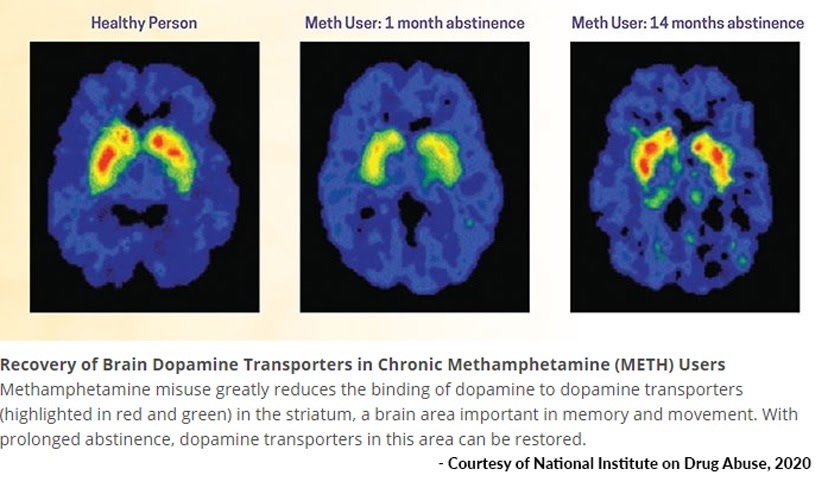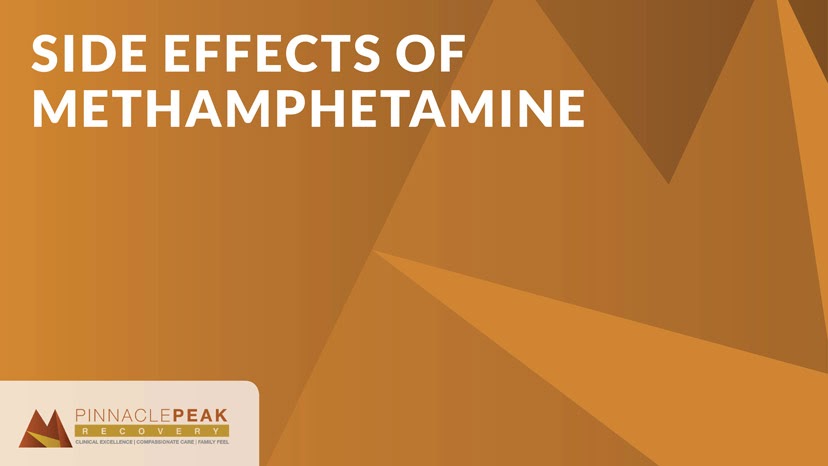Side Effects of Methamphetamine: What’s Happening To Your Body and Mind?
The importance of side effects is one of the main considerations someone should give when they are ingesting something into their body.
Yet, too often it becomes the sped-up language at the end of commercials, seeming more of an afterthought rather than a big decision with long-term consequences.

Or the side effects aren’t really considered because maybe the person using a substance, such as methamphetamine, is focused solely on the high they have achieved. A first-time user might get caught up in the newness of it, but not believe they need to worry about side effects as they have no plan to use the drug again.
Someone else may have lost their job and family in pursuit of their addiction and have such low self-esteem, or be so depressed, they don’t even care anymore about the results.
Our detox and meth treatment program can help both clients and families. This is the clinical excellence that Pinnacle Peak Recovery promises its client family. Our vast knowledge of methamphetamine side effects, both long-term and short-term, and withdrawal process go into our approach to achieve consistent care with proven results.
Meth is manufactured as a white powder and is typically considered a drug obtained on the party circuit to produce a euphoria to enhance the bacchanalian atmosphere. But that could be an outdated view.
If someone is looking to stay awake—think mothers, over-the-road truckers, frazzled college students—meth may be what they believe is the answer to a short-term problem.
Someone hoping to lose some weight might be drawn to meth because it is known to suppress appetite.
From a harried accountant during tax season to a bride-to-be to your friend from work—anyone could use meth and fall victim to its highly addictive draw.
The first time most people use meth, their intentions might be quite naive and more curious to “see what it’s all about.” With more frequent use, their naivety turns to a craving, exhausting to both mind and body.
The fun-loving partier can sadly turn desperate and homeless, as they put aside responsibilities in favor of pursuing that first-time euphoria they remember and long for. Seeing family and loved ones go through this is painful, and being the person devolved to this state, perhaps yourself, is terrifying.
Meth Addiction in Arizona

If you’re wondering how widespread methamphetamine distribution is in the Grand Canyon state of Arizona, its largest metropolitan region of Maricopa County, and major anchor city of Phoenix, look no further than this:
- November 2020 saw the largest-ever meth seizure along the border when a tractor-trailer laden with 600 packages and valued at nearly $690,000 was stopped.
- In October 2020, an Arizona state trooper made the largest meth seizure on record with the agency, discovering 464 pounds of meth, along with other drugs, for a total street value of $2.9 million.
- In September 2020, a car along I-40 in Kingman, northwest of Phoenix, was stopped with 80 pounds of meth valued at $3.9 million.
- The United States Drug Enforcement Administration calls Phoenix a major meth distribution hub and announced Operation Crystal Shield to step up efforts to get meth off the streets. As of October 2020, the endeavor had seized product equivalent to 8.8 million individual doses across Arizona.
- From October 2018 to September 2019, more than 500 individuals in Maricopa County died from meth-related overdoses; 100 of those were in one month, possibly correlating to the meth being laced with other substances. Lacing is increasingly common to maximize profits with lower-weight additives and most likely unknown to both the dealer and the user, as this is done during manufacturing elsewhere.
- Federal drug enforcement terms meth the No. 1 drug threat in the state.
Methamphetamine Side Effects on Mind and Body
As with many drugs, addictions begin as tolerance increases. Therefore, to get the high reminiscent of the first use, more frequent and/or higher dosing is pursued. As the history of use builds to a chronic level, the body will begin to show external signs of internal damage.
Methamphetamine is a powerful, highly addictive, human-made stimulant on the central nervous system. It produces a euphoric feeling through the release of dopamine, which acts on pleasure points in the brain.
Normally the dopamine transmitter would return to its initial home base, but meth blocks this action and builds up a burst of dopamine, producing the euphoric high. The “very high” levels of dopamine reward may be behind the brain being taught to repeat the activity. Meth leaves destructive results to brain function long after the high. With abstinence of at least 14 months, nerve damage and dopamine minders may be restored.

Methods of Meth Use
Smoking meth is the most addictive form, but it can also be
- Injected via a needle in liquid form (25%)
- Snorted nasally as powder form
- Swallowed in pill form
Short-Term Side Effects of Meth
- Euphoric rush
- Increased physical activity, including libido
- Fidgeting
- Hyperalertness
- Decreased appetite
- Heart conditions (increased blood pressure, irregular heartbeat, and rapid heart rate
- Elevated body temperature (can cause death)
- Convulsions (can cause death)

Long-Term Side Effects of Meth
When used long-term, methamphetamine ironically can make the person addicted feel simply numb when they initially pursued it for a euphoric effect.
The National Institute on Drug Abuse released a September 2020 research report summarizing the long-term effects of methamphetamine misuse. The report details meth’s neurological effects on the brain, in essence, altering normal brain functions and structure.In addition to numbness, side effects include
- Anxiety
- Insomnia
- Confusion
- Violent outbursts
- Tooth decay/loss from poor hygiene
- Mood disturbances
- Decrease in libido
- Skin sores from scratching related to psychotic symptoms (see below) causing itchiness
- Increased risk of stroke or Parkinson’s disease
- Impaired ability to focus
- Decreased cognitive function
Psychotic symptoms are also common through abnormal thinking and perceptions. The psychotic symptoms can last months or years and even spontaneously occur years later when under the extreme duress of anxiety.
These include
- Paranoia
- Sensory hallucinations (such as hearing or seeing people or insects that aren’t there or feeling something crawling on or under the skin)
Because meth impairs the brain’s flexibility, the report hypothesized this could be the root of why it is difficult to treat, and in early treatment, relapse may be common.
The Meth Addiction and Abuse Cycle
Meth use typically has four phases:
- Rush: This is a nearly instantaneous feeling of euphoria.
- High: Right after the rush, the pleasurable high will last upwards of 15 hours.
- Repeat: The rush/high cycle can repeat for a period lasting days or two weeks with minimal eating and sleeping.
- Shutdown: When the repeat cycle ends, psychological shutdown begins (also known as tweaking). Loss and craving remain, and nothing fills this void.
Hibernation occurs when the four cycles have concluded as the body demands sleep. Lasting sometimes days, it concludes with a hungry, thirsty person in need of bathing. As withdrawal begins to come knocking, the body can be fed, bathed, hydrated, and made ready to begin the cycle again.
Understanding and Research into How Meth Finds Its ‘Users’
The term “user” is considered to be derogatory in nature within the substance use treatment field.
Think about it: “Meth user” implies the issue of drugs without considering the human aspect. The phrase “a person using meth,” better conveys the person who is wanting a result through the substance use, oftentimes seeking pleasure to mask painful emotions.
The Centers for Disease Control and Prevention studied methamphetamine demographics for three years and released a March 2020 study estimating 14.7 million people have used meth in their lifetime and 1.63 million in the previous year.
Co-occurring substance disorders and mental illnesses are common, which is important to note when seeking effective treatment. Ensuring each addiction and disorder have been addressed through treatment is paramount for recovery efforts.

Pinnacle Peak Recovery Meth Detox, Rehab, and Recovery
There are thousands of Katies, Nicks, Anitas, Johans, Harrises, Joeys, and Amys in the United States and within Arizona who have fallen by the addiction wayside. Each one of them has a unique story, like you.
Treatment offers a way out, and the path can be challenging. Because of the side effects which can be painful and long-lasting, many fall back into the pattern just to find relief. It may take several rehab stays and longer lengths of time to get on track. As small steps become daily patterns and evolve into weeks or months of therapy and tools, the person who came in our doors scared will leave feeling like family.
Successful, safe, and clinically-excellent treatment from staff that understands this specific detox and recovery program needs. Pinnacle Peak Recovery nurtures clients and their families back to a successful path and recovery. Call us today at 866-377-4761.
FAQs:
How long do the side effects of meth last?
A meth high is felt almost instantaneously and is felt for up to 15 hours. The person using meth might repeat this cycle for days or even up to two weeks before they need to shut down and rest. Withdrawal symptoms will be evident shortly after.
What are the long-term side effects of smoking meth?
About 25% of people who use meth consume it by smoking. Long-term impacts are meth mouth from poor hygiene to possible stroke due to neurological impact. In between, commonly-reported side effects include decreased libido, sudden-onset paranoia after abstinence, anger outbursts, and even hallucinations where insects are perceived to be crawling on someone.


